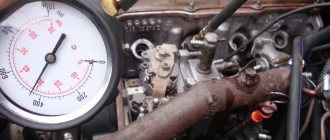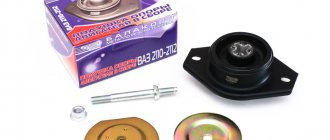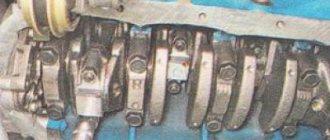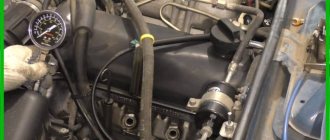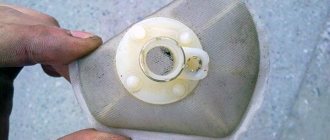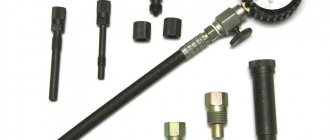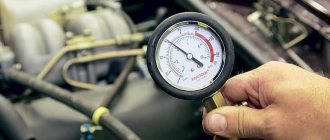03/04/2022 7 126 VAZ 2110
Author: Ivan Baranov
By measuring compression in cylinders, you can diagnose the parts of the power unit without disassembling it. For correct diagnosis, you need to know what compression should be in the VAZ 2110 engine. The article contains information on methods for measuring compression and detailed instructions with a video test of a 16-valve engine.
[Hide]
What compression in the cylinders of an 8-valve VAZ-2110 engine is considered normal?
Normal cylinder pressure on a VAZ-2110 with 8 valves should be from 10 to 12 atmospheres.
In some cases, the pressure in different cylinders may differ. If the indicator is 0.5-0.7 atmospheres, then such compression is normal and should not cause concern.
Reasons for falling below compression:
- The cylinder block gasket has burnt out;
- Burnt out pistons or valves;
- The cylinder-piston unit is worn out;
- Valve seats are damaged or destroyed;
- A crack has formed in the exhaust valve disc.
AvtoVAZ indicates the normal compression level and compression ratio for each engine. Many users confuse the characteristics, considering them one of the same. The compression ratio is the ratio of the total volume of the cylinder to the volume of the combustion chamber. To calculate the optimal compression ratio for an engine, use the formula:
Compression = Compression Ratio * K Factor.
In the case of gasoline engines, the coefficient is 1.2, while for diesel versions it is 1.8.
Design features
The main part of the engine, the cylinder block (catalog number 11193-1002011), also differs in size from its predecessor. It is factory painted blue. Its height, the distance from the crankshaft axis to the upper plane, became 197.1 mm, versus 194.8 mm on the 2112 model.
The dimensions of the holes for the block head mounting bolts have changed; they are from the hoist with M10×1.25 threads. The main bearing supports on the 124th engine, from the second to the fifth, are equipped with channels designed to supply oil that cools the piston during operation.
The crankshaft installed is the same as on models 21126 and 11194, with the marking 11183 cast on the sixth counterweight. Due to the crank radius of 37.8 mm, a piston stroke of 75.6 mm was provided. A toothed pulley is installed on the shaft for timing belt drive. The belt is 25.4 mm wide and has 136 teeth, parabolic in shape. Belt service life is 45,000 km.
The pulley is designed to drive additional units using a V-belt. Three types of belts are used, differing in length, depending on the equipment:
The pulley is designed in such a way that it acts as a damper, reducing the torque loads acting on the shaft. Another function is to determine the position of the crankshaft using a sensor and a gear mounted in the damper.
The improvement affected the pistons. Their bottoms are made with valve recesses 5.53 mm deep to avoid the valves hitting the piston bottom when the timing belt breaks.
On previous VAZ 16v models without recesses or with recesses of shallower depth, in such a situation there was a risk of bending the valves, which led to expensive repairs. So, concerns and frequently arising questions about whether the valves bend on this engine have been removed.
Oil scraper and compression rings are made of steel or cast iron. The pistons and connecting rods are connected using floating pins, 22 mm in diameter, 60.5 mm in length, secured with retaining rings. The pins and connecting rods are borrowed from the VAZ 2110 modification.
The block head for the 16 valve LADA 21124 engine has an enlarged docking area for the intake manifold flange. Both camshafts for the exhaust and intake valves, as well as the valves themselves, springs, and hydraulic compensators have also been preserved from the previous modification of the engine.
In order to avoid confusion, the shafts are marked with a digital code. If it ends at 14, then this is the exhaust valve shaft, if at 15, then this is the intake shaft.
Another difference is that there is a raw strip on the intake shaft, next to the first pushrod. By adding hydraulic compensators to the design, the manufacturer eliminated the need to maintain valves in terms of adjustment. But, they are very sensitive to the cleanliness and quality of the lubricant. Low-quality oil will quickly damage parts and must be replaced; such repairs are not provided for the VAZ 124.
The spring-valve group is similar to model 2112. Valves with one spring and rods with a diameter of 7 mm (on eight-valve heads their diameter is 8 mm). Toothed pulleys with marks for setting the valve timing are installed on the camshafts. Compared to model 2112, the marks are shifted relative to each other by 2°.
Just like the shafts, the pulleys have differences in design and markings - on the inlet, a strip is welded on the back side, on the outlet it is missing. Both pulleys have markings in the form of circles on the hub.
Correct belt tension is done using support and tension rollers with flanges (to eliminate the possibility of slipping).
The cylinder head gasket is made from asbestos-free material. The holes for the cylinders are made with metal edging.
The intake manifold is combined with the receiver and is made of plastic.
For the first time in cars of the VAZ 2110 family, a catalytic converter was installed, combined with an exhaust manifold. Depending on what EURO 4 or 5 requirements the 124 motor is designed for, a different type of collector is installed.
The design of the fuel rail was updated and it began to be made from stainless steel. The drain line was removed from the fuel system; instead, a bypass valve was installed on the pump to relieve excess pressure. To supply fuel directly to the cylinders, nozzles manufactured by Bosch and Siemens were used.
The ignition coils were installed on spark plugs, each spark plug had its own individual coil, with additional fixation to the valve cover. With this method, high-voltage wires were no longer needed, and the ignition control began to be carried out by Bosch M7.9.7 or Russian January 7.2 control units, intended for EURO-4 and 3.
Pressure measurement
We have already answered what the normal compression for a VAZ 2114 should be. Now let's look at how to actually measure it? First we need a special device called a compression meter.
All measurements using it are performed in the following order:
To measure pressure you will need a device - a compression meter. Using a compression gauge, take measurements in the following order:
- Fully charge the battery;
- Warm up the engine to 75-90 C°;
- After the engine warms up, remove all spark plugs;
- Disconnect the fuel supply hose;
- Insert the measuring device into the first spark plug hole;
- Press the gas pedal and hold it (you will need an assistant);
- Start the starter and turn the crankshaft with it;
- Wait until the readings on the dial (monitor) of the device reach the maximum - the indicator will be the compression value in a particular cylinder;
- Move the compression gauge to another spark plug hole and repeat the measurements.
After the pressure is measured in all cylinders, conclusions can be drawn about the general condition of the engine and the need for its repair/restoration.
After checking all cylinders, it is possible to draw a conclusion about the condition of the engines, as well as determine the need for restoration, repair or replacement.
If the compression norm is violated, it is recommended to stop traveling by car and get it repaired. Operating the vehicle in this condition may result in engine damage.
Source
Normal compression on a VAZ-2110
Typically, compression is checked using a special device. It is recommended to do this regularly.
This helps determine the degree of wear of the motor and rings, as well as the piston itself. Normal cylinder pressure on a VAZ-2110 with 8 valves should be from 10 to 12 atmospheres .
Normal compression in the cylinder.
It is also worth noting that sometimes the pressure in different cylinders may differ . If it is 0.5-0.7 atmospheres , then this phenomenon is normal and should not cause concern.
Abnormal compression
This happens when there are more or less atmospheres in the cylinder than in others.
Such an engine will not be able to operate normally. He absolutely needs to carry out repairs.
Causes
Burnout of the gasket between the block and the head is a fairly common defect.
conclusions
Knowing these points, you should not worry about the difference in compression in different cylinders on a VAZ-2110, if it is small. When the standard exceeds acceptable values, repairs will be required .
Engine compression indicates the condition of the engine, its service life, power, and torque. This procedure must be performed every 20-30 thousand kilometers, as well as before purchasing a car. Even when checking at a service center, YOU will need knowledge on how to correctly measure compression, because service people love to deceive and make money from you.
How to install a compressor with your own hands?
When the old device is faulty, you need to install a new one (see photo). The installation of a compressor on a VAZ is carried out in a short period. This is not a labor-intensive process, but requires extreme care and caution. To work you will have to equip yourself with the following equipment:
- set for compressor installation;
- keys;
Compressor installation diagram
- air filter system;
- pressure controller;
- paste based on abrasive components.
Before starting work, make sure that the power unit has completely cooled down, otherwise you may get burned. The work begins with dismantling the air duct and filter. The manifold clamps are removed. Now the fasteners of the part, which is popularly called a snail, are installed on the motor block.
We replace the drive belt with a belt taken from the compressor unit kit. It is more efficient, reliable and will last much longer. We adjust the belt so that it is not too tight, but not too loose. The next stage is the installation of the air duct and fastening of the pressure controller.
A filter is attached to the compressor outlet. The last stage of the work is to adjust the injector so that the power unit does not receive a lean mixture. It’s better to check this at a service center, since doing this operation yourself is problematic.
This is the entire list of work to replace the compressor. It may seem too complicated for a beginner, but in fact there is nothing difficult here. You should carry out the described work 1-2 times in the presence of a knowledgeable master, and this skill will be practiced to an automatic level.
Over time, car parts wear out, not only the chassis, but also the engine. Why is a cylinder compression test required? For example, you are buying a used car, and in order to find out what condition the engine is in, it is better to play it safe and check the compression so that you do not have to do a major overhaul after a couple of months. I bought my 10 when it was 5 years old; by that time the mileage was no longer low (about 90,000). When inspecting the car, I had a specialist with me who checked the compression in the cylinders.
If you notice that the engine does not pull, and at the same time the fuel and oil consumption has increased, then you should perform engine diagnostics. You can determine the causes of engine ailments without disassembling if you measure the compression in the engine cylinders. Engine compression is the pressure in the cylinders at the end of the compression stroke. It is measured in kg/cm2, bar, MPa or atmospheres. When the VAZ compression is high, then fewer gases will break into the engine crankcase and, therefore, more gases will do useful work, and this will have a positive impact on engine power. Thus, compression in the engine affects throttle response, engine stability, gasoline and oil consumption. Low engine compression will lead to a drop in engine power, a decrease in the vehicle's maximum speed, worse acceleration dynamics, and an increase in the amount of fuel and oil consumed.
engine 21124 16V
Engine VAZ 21124 16 valves Characteristics of engine 21124
Years of manufacture – (2004 – today) Cylinder block material – cast iron Power system – injector Type – in-line Number of cylinders – 4 Valves per cylinder – 4 Piston stroke – 75.6mm Cylinder diameter – 82mm Compression ratio – 10.3 Engine capacity VAZ 21124 – 1599 cm3. Engine power 21124 – 89 hp. /5000 rpm Torque - 131 Nm / 3700 rpm Fuel - AI95 Fuel consumption - city 8.9 l. | track 6.4 l. | mixed 7.5 l/100 km Oil consumption - 50 g/1000 km Engine 21124 oil: 5W-30 5W-40 10W-40 15W40 How much oil is in the VAZ 21124 engine: 3.5 l. When replacing, pour 3.2 liters.
Engine life 21124: 1. According to the plant - 150 thousand km 2. In practice - 200-250 thousand km
TUNING Potential – 400+ hp. Without loss of resource - up to 120 hp.
The engine was installed on: VAZ 21104 VAZ 21114 VAZ 21123 “Coupe” VAZ 21124 VAZ 2114 Super Auto (211440-24) Malfunctions and repairs of engine 21124
AvtoVAZ continues to develop 16 valve engines and in 2004 the VAZ 2112 engine was replaced with a 124 engine. It uses a Kalinovsky high block, it is 2.3 mm higher compared to the old block 2112, the piston stroke has increased from 71 mm to 75.6 mm, due to this the volume has become 1.6 liters. On the same block, behind the air filter, above the gearbox casing, there is a platform on which the VAZ engine number 21124 is stamped. By adapting the 124 engine to Euro-3 standards, its environmental performance has increased, low-end traction has appeared, the engine has become quieter and a little noisier than the twelfth . Engine 2110 124 1.6 l. injection in-line 4-cylinder with overhead camshafts, the gas distribution mechanism is belt driven. The service life of the 21124 motor, according to the manufacturer’s data, is 150 thousand km; in practice, the motors run about 200 and even 250 thousand km.
This engine solves the problem of 16-valve engines - the VAZ 21124 engine does not bend the valve, for this purpose there are holes on the bottom of the piston and with standard shafts or sports ones with moderate lift, the owner has nothing to fear. Among the disadvantages, it is necessary to tighten the timing belt once every 15 thousand km. If the VAZ 21124 engine is troublesome, there is a knocking or noise, do not be afraid, this is a common situation for AvtoVAZ. According to general reviews, the 124 engine is considered one of the best VAZ engines and is recommended for purchase, especially if major improvements are planned. In 2007, a new engine was released, replacing the 124th engine - the well-known Priora engine. In addition, based on the 124 engine, the Super-Auto company produced a 1.8 liter VAZ 21128 engine, something is also said about it above.
There is no point in considering chip tuning of a 124 engine, it will not make any noticeable changes on a standard car, the firmware is needed for more thorough and correct tuning, after the engine has been modified, we will start with it. The simplest and most standard way to increase the power of the 21124 engine is to replace the camshafts with Stolnikov 8.9 280 or Nuzhdin 8.85, install a direct-flow exhaust 4-2-1, a receiver and a 54-56 mm damper, this will give us a total of more than 120 hp, and For more efficient operation of the engine, we change the piston to a lightweight Priora one, this will additionally increase power and reduce fuel consumption.
Source
Repair
As can be seen from the above, there are many reasons for different compression in the cylinders. In this case, it is not always possible to carry out repairs yourself, especially if you do not have the skills. In this case, it is recommended to contact specialists at a service station.
Traditional methods of increasing compression
It is noted that the methods described below cannot be a 100% guarantee that compression in the cylinders will increase.
- Buy a quality valve cleaning fluid and pour it into the oil.
- Pour this liquid into the cylinders overnight.
A popular way to eliminate stuck rings and increase compression
This method does not guarantee that the compression meter readings will change. But, it is actually effective if different compression in the cylinders was formed precisely because of the position of the rings. At a minimum, your conscience will be clear, and you will then exclude this item from the diagnosis.
If in one of the “pots” the pressure is significantly lower than in the others (for example, everywhere is 11.5, and in the only one 6.0 atmospheres), this indicates a difference in compression. Naturally, this negatively affects the operation of the power unit. Often a drop in compression can be observed in several “pots”. However, in this case, we can safely say that the engine needs urgent overhaul. There can be many reasons for a drop in compression; elimination requires dismantling the cylinder head. Here are the main reasons: 1. Broken (burnt-out) cylinder head gasket. One of the most common causes is “treated” by replacing this element. 2. The cylinder head is not tightened enough. Actually, the above reason follows from this: the gasket begins to leak pressure and eventually breaks through. 3. Rings are skipped. This phenomenon occurs if the o-rings are severely worn or broken. If the pressure drops in one “pot”, the rings are guaranteed to be broken. In this case, a major overhaul of the engine is required. 4. Coking. The rings become coated with coke due to the use of low-quality motor oil or due to high mileage. The oil burns out and the rings stick in one place, unable to move along their grooves. Only one side is ground down, which means the engine wears out faster. Coking is indicated by a drop in compression in all cylinders. 5. Wear of the walls of the cylinder block. This is a rare phenomenon and most often occurs due to the manufacturer using low-quality materials. 6. Engine overheating. If the engine overheats, the rings and the walls of the block begin to leak pressure, and with it the oil. Partially can be identified by the bluish smoke from the exhaust pipe. 7. Piston burnout. If the piston is broken, the compression in the cylinders will be virtually zero. It can burn out from both the top and the side. Often, pistons break when the timing belt breaks when, due to a violation of the valve timing, they meet the valves. 8. Valves. Compression may drop due to improper adjustment, burnout or breakage when the timing belt breaks.
Examination
It is recommended to check the compression on the VAZ 2110 regularly to prevent possible malfunctions and problems with the engine. Measurements are taken with the throttle valve open and closed. Each test option gives its own results and data on the condition of the engine.
Checking with the valve open allows you to determine:
- Problems and damage on cylinder surfaces;
- Deformation, burnout of valves;
- Sticking or coking of piston rings.
If you check the compression with the throttle closed, you can find out:
- Are the valves stuck?
- Is there a tight fit to the valve seat?
- If a hydraulic tappet is present, the presence of defects in the camshaft cam profile is determined.
Now you can proceed directly to the verification.
- Warm up the engine until it reaches operating temperature, then turn off the ignition.
- Turn off the fuel pump. If it is a mechanical pump, the tubes are disconnected and the fuel supply is cut off. In the case of an electric fuel pump, simply turn off the fuel supply relay and remove the fuse.
- Relieve the pressure that is inside the fuel system.
- Start the engine. This way the engine will be able to use up all the fuel that remains in the system. Wait until the engine comes to a complete stop.
- Now we continue to measure the compression.
- Disconnect the ignition module.
- Disconnect the spark plugs from the high-voltage circuits, then use a special spark plug wrench to unscrew them from their sockets.
- Insert a measuring device into the spark plug socket. On each cylinder, that is, when connecting the device to each hole, measurements are taken separately.
- Invite an assistant. His job is to sit in the driver's seat and press the gas pedal to open the throttle.
- At the same time, the engine starts for 5-10 seconds.
- At this moment you are taking readings from the measuring device.
- Using a similar method, you should take measurements on each cylinder, resetting the readings of the previous one on the device. Record your findings.
